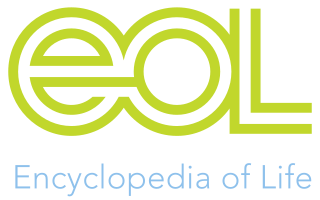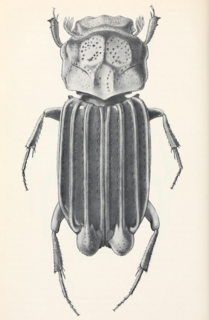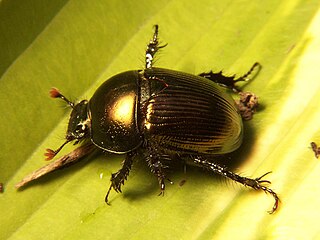
The acouchis are rodents belonging to the family Dasyproctidae from the Amazon basin. They are generally smaller than agoutis and have very short tails, while agoutis lack tails. For this reason the acouchis are also called tailed agoutis.
Glaresis is a genus of beetles, sometimes called "enigmatic scarab beetles", in its own family, the Glaresidae. It is closely related to, and was formerly included in, the family Scarabaeidae. Although its members occur in arid and sandy areas worldwide, only the nocturnal adults have ever been collected, and both the larvae and biology of Glaresis are as yet unknown. Due to their narrow habitat associations, a great number of these species occur in extremely limited geographic areas, and are accordingly imperiled by habitat destruction.

The Encyclopedia of Life (EOL) is a free, online collaborative encyclopedia intended to document all of the 1.9 million living species known to science. It is compiled from existing databases and from contributions by experts and non-experts throughout the world. It aims to build one "infinitely expandable" page for each species, including video, sound, images, graphics, as well as text. In addition, the Encyclopedia incorporates content from the Biodiversity Heritage Library, which digitizes millions of pages of printed literature from the world's major natural history libraries. The project was initially backed by a US$50 million funding commitment, led by the MacArthur Foundation and the Sloan Foundation, who provided US$20 million and US$5 million, respectively. The additional US$25 million came from five cornerstone institutions—the Field Museum, Harvard University, the Marine Biological Laboratory, the Missouri Botanical Garden, and the Smithsonian Institution. The project was initially led by Jim Edwards and the development team by David Patterson. Today, participating institutions and individual donors continue to support EOL through financial contributions.

Aegialia is a genus of aphodiine dung beetles in the family Scarabaeidae. There are at least 30 described species in Aegialia.
Mycale cartwrighti is a species of demosponge first found on the coast of South Georgia island, in the south west Southern Ocean.

Cartwrightia is a genus of scarab found in Latin America. It was named and circumscribed in 1958 by Federico Islas Salas. As of 2017, three species are recognized: C. intertribalis, C. cartwrighti, and C. islasi. They can be found in the nests of leafcutter ants or in dung.

Cartwrightia cartwrighti is a species of aphodiine scarab found in South America. Oscar L. Cartwright named the species in 1967 after his brother. C. cartwrighti has been recorded in pastures and forests. It has also been found in cow dung.
Mycotrupes lethroides is a species in the family Geotrupidae, in the order Coleoptera ("beetles"). Mycotrupes lethroides is found in North America.
Mycotrupes retusus is a species in the family Geotrupidae, in the order Coleoptera ("beetles"). The species is known generally as the "sandhills earth boring scarab beetle". It is found in North America.
Mycotrupes is a genus of earth-boring scarab beetles in the family Geotrupidae. There are at least 5 described species in Mycotrupes.

Geotrupinae is a subfamily of earth-boring scarab beetles in the family Geotrupidae. There are more than 30 genera and 450 described species in Geotrupinae.

Bolbocerosoma is a genus of earth-boring scarab beetles in the family Bolboceratidae. There are about 13 described species in Bolbocerosoma.
Aegialia cartwrighti is a species of aphodiine dung beetle in the family Scarabaeidae. It is found in North America.
Peripsocus is a genus of stout barklice in the family Peripsocidae. There are more than 250 described species in Peripsocus.

Hoplitis is a genus of bees in the family Megachilidae. There are more than 380 described species in Hoplitis.

Atomaria is a genus of silken fungus beetles in the family Cryptophagidae. There are more than 160 described species in Atomaria.
Stylurus spiniceps, the arrow clubtail, is a species of clubtail in the dragonfly family Gomphidae. It is found in North America.
Rhagonycha cartwrighti is a species of soldier beetle in the family Cantharidae. It is found in North America.
Mycotrupes gaigei, the North peninsular mycotrupes beetle, is a species of earth-boring scarab beetle in the family Geotrupidae. It is found in North America.










